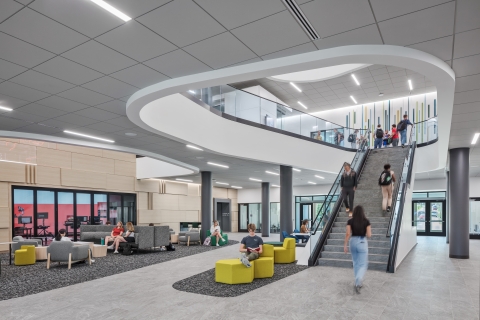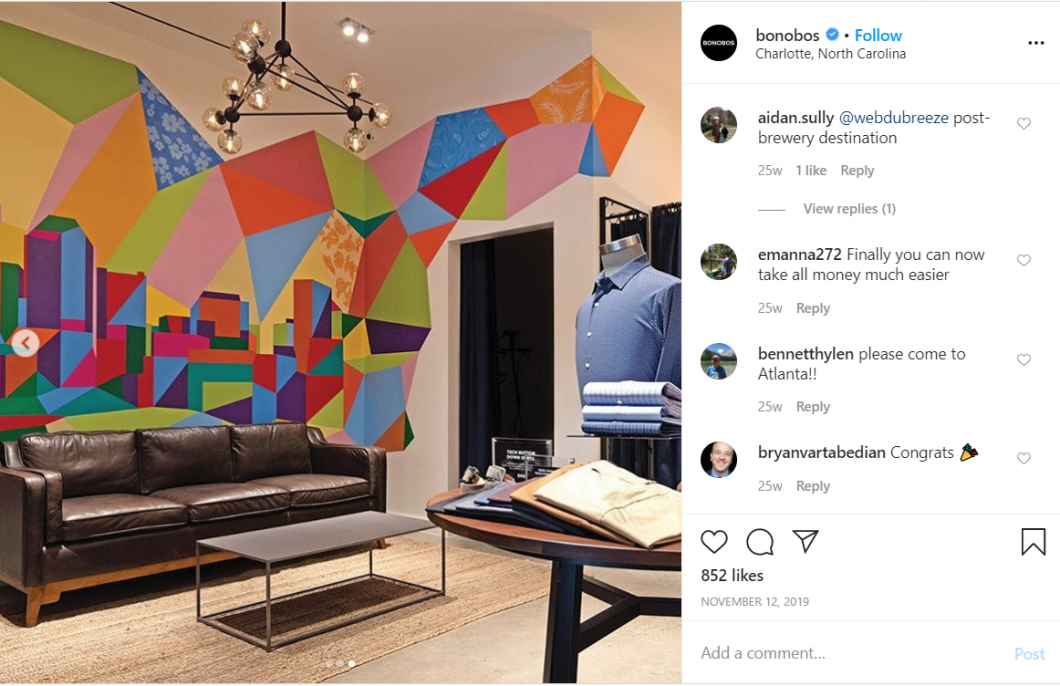
What Do Shoppers Really Want?: Lessons Learned from Clicks to Bricks

The announcement of a Bonobos store opening (pictured above) garnered hundreds of likes and comments.
It’s a whole new era for retail. It wasn’t that long ago when the mall was “the” place to shop—the epicenter of retail, where a less saturated collection of brands co-existed in harmony. Over the last decade, shopping habits changed, and many categories became crowded which triggered fierce competition among brands. These issues are creating new challenges for traditional mall retailers, even causing some to go out of business or barely cling to life. The future of the traditional mall format is in question. Yet, even before COVID-19 and social distancing restrictions, many retail spaces in malls were already unoccupied and the COVID-19 pandemic is accelerating this. Now the tide is turning. While online shopping is currently the preferred method due to the pandemic and, in some cases, the only available method of shopping, shoppers’ choices are on the increase as retailers are reevaluating the physical space.
One portion of the retail category that is “getting it right” is the Clicks-to-Bricks (C2B) segment—those previously online-only retailers that ventured into brick and mortar physical retail spaces. C2B retailers understand how to compete successfully and survive by listening to shoppers, understanding their habits, uncovering their unmet needs, and finding new ways to attract them.
Matching expectations and experiences from clicks to bricks
BHDP, an international, award-winning retail design firm, initiated research to learn more about shoppers’ behaviors, both online and offline. To accomplish the goal, the firm engaged an independent, online market research group to gather input from 1,000 adult U.S. shoppers between February and March 2020. These shoppers were required to have experience purchasing both online and in a physical store from a list of established C2B retail brands. This research revealed the importance of fulfilling shoppers’ expectations through a holistic brand experience. Almost three-quarters (69 percent) of shoppers who shopped at the brands’ retail stores after making an online purchase believed that the in-store brand matched the online brand.
“I expect the in-store aesthetic to be similar to the colors and design of the website.”
Clicks to Bricks Shopper
This was primarily due to product availability (63 percent) and the décor or aesthetics of the physical retail space (33 percent). “I expect the in-store aesthetic to be similar to the colors and design of the website,” said one shopper. The majority of these shoppers (89 percent) were extremely or somewhat satisfied with their in-store experience compared to their online experience. “Found exactly what I was looking for, and if I couldn’t, staff was happy to help. Much like [the] search bar online,” said one shopper.
Brand consistency is critical. There shouldn’t be a disconnect between the online brand and the in-store brand experience. Successful retailers create a seamless transition from online to in-store shopping by designing the physical space to reflect the aesthetic and voice of the online shopping experience and bringing their brand equities to life in a physical form. Fifty-seven percent of those surveyed shopped at the C2B’s retail store after purchasing from their online site. One shopper, commenting on the décor and aesthetics of the retail store and how it positively reflected the online brand experience, stated, “It felt like a candy shop, the feeling you get visually by looking at the website.” Overall, shoppers expect that items will be the same price and quality whether purchased online or in a retail store. They also expect the retail store to offer similar return policies and customer service as compared to the online site. Shoppers want the store to feel like a full shop and not one that only carries limited products. One shopper stated, “It should be nice and resemble your online shopping experience,” while another said, “I expect there to be perks to encourage me to shop in-store instead of online, like helpful representatives and the ability to try on products.
Understand the shopper
Online brands excel at collecting data about their shoppers and shaping the online buying experience to match their shoppers’ wishes and desires. Traditional retailers, however, struggle to capture data from their customers to understand their behaviors. Shoppers want the opportunity to touch and feel the products and leave the store with product in hand or ordered with free shipping if the product is not available in-store. “There has to be a big reason for me to go into the store. Probably the ability to try things on in many sizes/styles and get customer service when needed,” stated one shopper. Half of these shoppers stated that access to in-store personalized customer service affects their decision to visit a brick and mortar store and 58 percent of shoppers said it is important to be able to order online from a sales representative while shopping in-store.
It’s time for retailers to be more innovative and to create the authentic, in-store experience shoppers seek. Technology must be an integral part of capturing information about in-store shopper behaviors similar to how data is captured about online shopper behaviors. In-store technology can measure how long shoppers are in the store, where they move and linger, if they fulfill their purchase or leave unfulfilled, among other valuable data points. Additionally, AR and VR allow customers to virtually experience more products than are available in the store. C2B retailers also can strengthen the in-store experience, by offering:
“There has to be a big reason for me to go into the store. Probably the ability to try things on in many sizes/styles and get customer service when needed.”
Clicks to Bricks Shopper
- Professional and personal customer service and one-on-one consultative help.
- New technologies, such as kiosks, to assist shoppers in ordering directly from the website if the desired product is not available in-store, and test-fit products like cosmetics with virtual capabilities.
- The ability to observe the entire product line via monitors to compensate for smaller product assortments in-store.
- Options for shoppers to pay online after selecting their products in-store, to reduce the time spent waiting in check-out lines.
- Enhanced shopping experiences from the brand’s app. One survey discovered that 70 percent of Generation Z shoppers wanted to receive personalized recommendations from the brand’s app while they were browsing in the brand’s retail store.
- Amenities such as areas to recharge phones and free WiFi to appeal to Generations Z and Alpha and increase engagement while in the retail stores. Requiring sign-in for WiFi allows retailers to capture additional information.
Adapting retail experiences to COVID-19 restrictions
Traditional retail stores were hit hard by the COVID-19 restrictions, while online sales increased during the pandemic and in some cases and categories soared. As in-store shopping restrictions are starting to relax, retailers are figuring out how to entice shoppers to return to their physical stores. C2B retailers are ahead of the game when it comes to recovering from the COVID-19 crisis. Their ecommerce sites were already well established, and their customer base is comfortable with shopping both online and in-store. In fact, these shoppers typically research products heavily online first for selection and deselection before visiting the retail store for validation. This means they need less time in the store and are less likely to touch every product they see, which is more in line with the COVID-19 recommendations for reopening retail stores.
The role of a retail store is to be a place where shoppers can gather, connect, learn and discover. Even with the movement toward online shopping, many still want that in-store experience. Surprisingly, research with the Gen Z population discovered that 81 percent of those surveyed prefer shopping in retail spaces more than online.
DTC retailers should listen to their specific shoppers’ wants and desires as it pertains to in-store experiences and embrace the physical store model.
In fact, most Gen Z shoppers want to visit those retailers that provide more engaging in-store experiences. No matter the generation category, most shoppers expect convenience and the ability to fulfill their shopping needs immediately. They want reassurance of shopping securely. Most importantly, shoppers need to trust the brands they support, necessitating brands to realize and meet their expectations.
It’s not business as usual anymore for retailers. Shoppers now have full control—dictating what they want, when they want it, how they get it and where. With all of the available tools to capture valuable data about shopper behaviors, DTC retailers should listen to their specific shoppers’ wants and desires as it pertains to in-store experiences and embrace the physical store model. Meanwhile, traditional retailers can emulate the C2B model and be better prepared for future crises by learning more about how their loyal customers prefer to shop in a physical space and providing a cohesive online and in-store experience that satisfies their demands and desires.
This article was originally published in design:retail.

